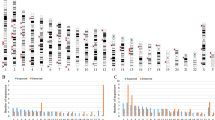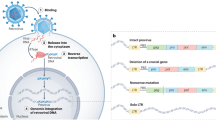Abstract
Human endogenous retroviruses (HERVs) account for approximately 8 % of the human genome. To date, several HERV families have been identified in the human genome, with some being valid biomarkers for specific disease states. In this study, we have identified three HERV-Y elements in the human genome and characterized their structure and expression in various human tissues. New HERV-Y elements (HERV-Y101, HERV-Y102, and HERV-Y103) were detected on human chromosomes 8 and 13. In a pol-based phylogenetic tree, HERV-Y elements were closely grouped with HERV-I, -T, -E, and –R. The HERV-Y pol gene was expressed ubiquitously in all examined tissues, and it was dominantly expressed in the pons among the 12 different brain regions investigated. These results will allow future studies to elucidate the potential functional roles of HERVs in the brain and other tissues.




Similar content being viewed by others
References
Katoh I, Kurata SI (2013) Association of endogenous retroviruses and long terminal repeats with human disorders. Front Oncol 3:234
Laska MJ, Nissen KK, Nexo BA (2013) (Some) cellular mechanisms influencing the transcription of human endogenous retrovirus, HERV-Fc1. PLoS One 8:e53895
Tristem M (2000) Identification and characterization of novel human endogenous retrovirus families by phylogenetic screening of the human genome mapping project database. J Virol 74:3715–3730
Blikstad V, Benachenhou F, Sperber GO, Blomberg J (2008) Evolution of human endogenous retroviral sequences: a conceptual account. Cell Mol Life Sci 65:3348–3365
Urnovitz HB, Murphy WH (1996) Human endogenous retroviruses: nature, occurrence, and clinical implications in human disease. Clin Microbiol Rev 9:72–99
Ruprecht K, Mayer J, Sauter M, Roemer K, Mueller-Lantzsch N (2008) Endogenous retroviruses and cancer. Cell Mol Life Sci 65:3366–3382
Zhao J, Rycaj K, Geng S, Li M, Plummer JB, Yin B, Liu H, Xu X, Zhang Y, Yan Y, Glynn SA, Dorsey TH, Ambs S, Johanning GL, Gu L, Wang-Johanning F (2011) Expression of human endogenous retrovirus type K envelope protein is a novel candidate prognostic marker for human breast cancer. Genes Cancer 2:914–922
Sverdlov ED (1998) Perpetually mobile footprints of ancient infections in human genome. FEBS Lett 428:1–6
Ahn K, Kim HS (2009) Structural and quantitative expression analyses of HERV gene family in human tissues. Mol Cells 28:99–103
Reis BS, Jungbluth AA, Frosina D, Holz M, Ritter E, Nakayama E, Ishida T, Obata Y, Carver BS, Scher HI, Scardino PT, Slovin SF, Subudhi SK, Reuter VE, Savage C, Allison JP, Melamed J, Jager E, Ritter G, Old L, Gnjatic S (2013) Prostate cancer progression correlates with increased humoral immune response to a human endogenous retrovirus GAG protein. Clin Cancer Res 19:6112–6125
Huh JW, Ha HS, Kim DS, Kim HS (2008) Placenta-restricted expression of LTR-derived NOS3. Placenta 29:602–608
Mi S, Lee X, Li X, Veldman GM, Finnerty H, Racie L, LaVallie E, Tang XY, Edouard P, Howes S, Keith JC Jr, McCoy JM (2000) Syncytin is a captive retroviral envelope protein involved in human placental morphogenesis. Nature 403:785–789
Dunn CA, Medstrand P, Mager DL (2003) An endogenous retroviral long terminal repeat is the dominant promoter for human beta1,3-galactosyltransferase 5 in the colon. Proc Natl Acad Sci USA 100:12841–12846
Jung YD, Lee JR, Kim YJ, Ha HS, Oh KB, Im GS, Choi BH, Kim HS (2013) Promoter activity analysis and methylation characterization of LTR elements of PERVs in NIH miniature pig. Genes Genet Syst 88:135–142
Chang NT, Yang WK, Huang HC, Yeh KW, Wu CW (2007) The transcriptional activity of HERV-I LTR is negatively regulated by its cis-elements and wild type p53 tumor suppressor protein. J Biomed Sci 14:211–222
McGee-Estrada K, Fan H (2007) Comparison of LTR enhancer elements in sheep beta retroviruses: insights into the basis for tissue-specific expression. Virus Genes 35:303–312
Lee WJ, Kwun HJ, Jang KL (2003) Analysis of transcriptional regulatory sequences in the human endogenous retrovirus W long terminal repeat. J Gen Virol 84:2229–2235
Goering W, Ribarska T, Schulz WA (2011) Selective changes of retroelement expression in human prostate cancer. Carcinogenesis 32:1484–1492
Tamura K, Stecher G, Peterson D, Filipski A, Kumar S (2013) MEGA6: Molecular Evolutionary Genetics Analysis version 6.0. Mol Biol Evol 30:2725–2729
Shin W, Lee J, Son SY, Ahn K, Kim HS, Han K (2013) Human-specific HERV-K insertion causes genomic variations in the human genome. PLoS One 8:e60605
Johnson M, Zaretskaya I, Raytselis Y, Merezhuk Y, McGinnis S, Madden TL (2008) NCBI BLAST: a better web interface. Nucl Acids Res 36:W5–W9
Garcia-Etxebarria K, Jugo BM (2012) Detection and characterization of endogenous retroviruses in the horse genome by in silico analysis. Virology 434:59–67
Cohen CJ, Lock WM, Mager DL (2009) Endogenous retroviral LTRs as promoters for human genes: a critical assessment. Gene 448:105–114
Bénit L, Dessen P, Heidmann T (2001) Identification, phylogeny, and evolution of retroviral elements based on their envelope genes. J Virol 75:11709–11719
Yi JM, Kim HS (2007) Expression and phylogenetic analyses of human endogenous retrovirus HC2 belonging to the HERV-T family in human tissues and cancer cells. J Hum Genet 52:285–296
van der Kuyl AC (2012) HIV infection and HERV expression: a review. Retrovirology 9:6
Yi JM, Kim TH, Huh JW, Park KS, Jang SB, Kim HM, Kim HS (2004) Human endogenous retroviral elements belonging to the HERV-S family from human tissues, cancer cells, and primates: expression, structure, phylogeny and evolution. Gene 342:283–292
Weiss RA (2006) The discovery of endogenous retroviruses. Retrovirology 3:67
Lower R, Lower J, Kurth R (1996) The viruses in all of us: characteristics and biological significance of human endogenous retrovirus sequences. Proc Natl Acad Sci USA 93:5177–5184
Qari SH, Magre S, Garcia-Lerma JG, Hussain AI, Takeuchi Y, Patience C, Weiss RA, Heneine W (2001) Susceptibility of the porcine endogenous retrovirus to reverse transcriptase and protease inhibitors. J Virol 75:1048–1053
Garcia-Etxebarria K, Jugo BM (2010) Genome-wide detection and characterization of endogenous retroviruses in Bos taurus. J Virol 84:10852–10862
Domansky AN, Kopantzev EP, Snezhkov EV, Lebedev YB, Leib-Mosch C, Sverdlov ED (2000) Solitary HERV-K LTRs possess bi-directional promoter activity and contain a negative regulatory element in the U5 region. FEBS Lett 472:191–195
Feuchter A, Mager D (1990) Functional heterogeneity of a large family of human LTR-like promoters and enhancers. Nucl Acids Res 18:1261–1270
Ahn K, Han K, Kim H-S (2011) Quantitative analysis of the HERV pol gene in human tissues. Genes Genom 33:439–443
Berkhout B, Jebbink M, Zsíros J (1999) Identification of an active reverse transcriptase enzyme encoded by a human endogenous HERV-K retrovirus. J Virol 73:2365–2375
Huang W-J, Liu Z-C, Wei W, Wang G-H, Wu J-G, Zhu F (2006) Human endogenous retroviral pol RNA and protein detected and identified in the blood of individuals with schizophrenia. Schizophr Res 83:193–199
Silver J, Maudru T, Fujita K, Repaske R (1993) An RT-PCR assay for the enzyme activity of reverse transcriptase capable of detecting single virions. Nucl Acids Res 21:3593
Yi JM, Kim HS (2007) Molecular phylogenetic analysis of the human endogenous retrovirus E (HERV-E) family in human tissues and human cancers. Genes Genet Syst 82:89–98
Kim HS, Yi JM, Hirai H, Huh JW, Jeong MS, Jang SB, Kim CG, Saitou N, Hyun BH, Lee WH (2006) Human endogenous retrovirus (HERV)-R family in primates: chromosomal location, gene expression, and evolution. Gene 370:34–42
Patzke S, Lindeskog M, Munthe E, Aasheim H-C (2002) Characterization of a novel human endogenous retrovirus, HERV-H/F, expressed in human leukemia cell lines. Virology 303:164–173
Christensen T, Dissing SP, Riemann H, Hansen H, Munch M, Haahr S, Møller-Larsen A (2000) Molecular characterization of HERV-H variants associated with multiple sclerosis. Acta Neurol Scand 101:229–238
Wang-Johanning F, Frost AR, Jian B, Epp L, Lu DW, Johanning GL (2003) Quantitation of HERV-K env gene expression and splicing in human breast cancer. Oncogene 22:1528–1535
Bénit L, De Parseval N, Casella J-F, Callebaut I, Cordonnier A, Heidmann T (1997) Cloning of a new murine endogenous retrovirus, MuERV-L, with strong similarity to the human HERV-L element and with a gag coding sequence closely related to the Fv1 restriction gene. J Virol 71:5652–5657
Kjeldbjerg AL, Villesen P, Aagaard L, Pedersen FS (2008) Gene conversion and purifying selection of a placenta-specific ERV-V envelope gene during simian evolution. BMC Evol Biol 8:266
Karlsson H, Schroder J, Bachmann S, Bottmer C, Yolken RH (2004) HERV-W-related RNA detected in plasma from individuals with recent-onset schizophrenia or schizoaffective disorder. Mol Psychiatry 9:12–13
Yolken RH, Karlsson H, Yee F, Johnston-Wilson NL, Torrey EF (2000) Endogenous retroviruses and schizophrenia. Brain Res Brain Res Rev 31:193–199
Frank O, Giehl M, Zheng C, Hehlmann R, Leib-Mosch C, Seifarth W (2005) Human endogenous retrovirus expression profiles in samples from brains of patients with schizophrenia and bipolar disorders. J Virol 79:10890–10901
Antony JM, Ellestad KK, Hammond R, Imaizumi K, Mallet F, Warren KG, Power C (2007) The human endogenous retrovirus envelope glycoprotein, syncytin-1, regulates neuroinflammation and its receptor expression in multiple sclerosis: a role for endoplasmic reticulum chaperones in astrocytes. J Immunol 179:1210–1224
Kolmac CI, Mitrofanis J (1998) Patterns of brainstem projection to the thalamic reticular nucleus. J Comp Neurol 396:531–543
Kim HS, Ahn K, Kim DS (2008) Quantitative expression of the HERV-W env gene in human tissues. Arch Virol 153:1587–1591
Schmahmann JD, Pandya DN (1997) Anatomic organization of the basilar pontine projections from prefrontal cortices in rhesus monkey. J Neurosci 17:438–458
Acknowledgments
This work was supported by a research program funded by the Korea Centers for Disease Control and Prevention (2013-E7200201; 4800-4845-301).
Conflict of interest
The authors declare no conflicts of interest.
Author information
Authors and Affiliations
Corresponding author
Electronic supplementary material
Below is the link to the electronic supplementary material.
705_2015_2486_MOESM1_ESM.pptx
Figure S1 Alignment of the HERV-Y elements and amplification regions. The HERV-Y elements are similar, but the primer binding sites differ slightly. Thus, the three loci were differentially amplified. (A) The HERV-Y101 sequence was aligned with HERV-Y101 (chr8:39738865-39739004), HERV-Y102 (chr8:42418923-42419025), and HERV-Y103 (chr13:111846985-111847124). (B) The HERV-Y102 sequence was aligned with HERV-Y101 (chr8:39738640-39738742), HERV-Y102 (chr8:42419148-42419287), and HERV-Y103 (chr13:111846760-111846862). (C) The HERV-Y103 sequence was aligned with HERV-Y101 (chr8:39738794-39738927), HERV-Y102 (chr8:42419077-42419210), and HERV-Y103 (chr13:111846914-111847047). Blue shading indicates the primer binding sites. Sequences that overlap with the amplification regions are indicated by dots. “Amp.” indicates amplification regions. (PPTX 60 kb)
Rights and permissions
About this article
Cite this article
Gim, JA., Han, K. & Kim, HS. Identification and expression analysis of human endogenous retrovirus Y (HERV-Y) in various human tissues. Arch Virol 160, 2161–2168 (2015). https://doi.org/10.1007/s00705-015-2486-z
Received:
Accepted:
Published:
Issue Date:
DOI: https://doi.org/10.1007/s00705-015-2486-z




